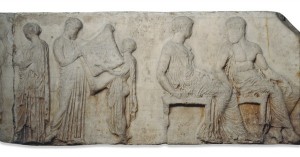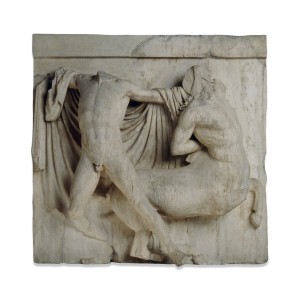To whom in the world does the Parthenon belong? Naturally, believing that the Parthenon resides in Athens, one might argue that the important historical building is the property of Greece. However, after portions of the building, wall friezes, and sculptures were removed and displayed within museums in other nations, the question of ownership is complicated. Roughly half of the frieze from the Parthenon, as well as a great number of sculptures, are now owned by the British Museum in London.

Central scene of the east frieze of the Parthenon
According to the British Museum, Lord Elgin acquired the “Elgin Marbles” while he was an ambassador to the Ottoman Court. He was granted the privilege of studying and rescuing antiquities as reward for his good service. After bringing the collection to his home in Scotland, Elgin later sold them to the British government which displayed them in the British Museum starting in 1816. While in its online articles about the Parthenon sculptures, the British Museum repeatedly claims that Elgin intended to donate the pieces to the Museum, it also acknowledges that Elgin encountered financial problems that forced him to sell the works to the government. This begs the question – what was Elgin’s intention? Did he always plan to donate his collection? Or did he plan to retain the works until he experienced financial trouble that spurred him to sell?
The British Museum argues that “Lord Elgin can only be judged by the standards of his own day.” (The Parthenon Sculptures: Facts and Figures) It justifies Elgin’s actions, and the Museum’s current ownership, by arguing that others both before and after Elgin’s time took pieces of the Parthenon that are now housed in Museums across Europe. Yet does this justify the Museum’s ownership? “Just because everyone else was doing it” is not an acceptable argument for why the British, and other nations, should own part of another country’s national heritage site.
More than just national heritage, The Parthenon is now part of a UNESCO World Heritage site that includes other monuments of the Acropolis in Athens. Greece has asked, both through UNESCO and a bilateral request to the British government, to have the Parthenon sculptures returned to their home in this World Heritage site. The British Museum rejected both these requests, asserting that the pieces have become an important part of world history within the context of other works from the museum. Further claims that having the Parthenon sculptures inspired European powers to aid the creation of the Greek state are a striking justification for housing the collection in London.

Marble metope from the Parthenon
One of the most complicating factors in the “Elgin Marbles” case is the question of preservation. If Elgin had not brought the Parthenon sculptures to London, would they have been destroyed? There was great damage to the Parthenon before Elgin arrived and increasingly damaging restoration work completed on the remaining portions in the 1920s and 1930s. Perhaps the Parthenon sculptures were safer in the protection of the British Museum. Yet who were they saved for? The British Museum places huge emphasis on being an educational resource for the world. However, removing these essential portions of the Parthenon to preserve individual statues and friezes, caused irreparable damage to the site and limits the view of the Parthenon for all peoples of the world who visit that site.
The future of the Parthenon sculptures is still undetermined. The British Museum Act of 1963 makes repatriation impossible without amendment. The British House of Commons completed a second reading of an Amendment to the British Museum Act of 1963 that would allow for the Museum to legally return the Parthenon to Greece. Perhaps with legislation change, the British Museum will consider the value of returning the Parthenon Marbles to Greece. For the time being, however, the British Museum believes that the Parthenon Marbles are an integral and historically important part of its collection.
For more information about the Parthenon sculptures at the British Museum:
The British Museum “What are the Elgin Marbles?”
The British Museum “Lord Elgin and the Parthenon Sculptures”
The British Museum “The Parthenon Sculptures: Facts and Figures”
The British Museum: “The Parthenon Sculptures: Stewardship”
BBC “Parthenon Marbles: Taking up the fight” by Trevor Timpson
